-
History of:
- Resources about:
- More:
- Baby walkers
- Bakehouses
- Bed warmers
- Beer, ale mullers
- Besoms, broom-making
- Box, cabinet, and press beds
- Butter crocks, coolers
- Candle snuffers, tallow
- Clothes horses, airers
- Cooking on a peat fire
- Drying grounds
- Enamel cookware
- Fireplaces
- Irons for frills & ruffles
- Knitting sheaths, belts
- Laundry starch
- Log cabin beds
- Lye and chamber-lye
- Mangles
- Marseilles quilts
- Medieval beds
- Rag rugs
- Rushlights, dips & nips
- Straw mattresses
- Sugar cutters - nips & tongs
- Tablecloths
- Tinderboxes
- Washing bats and beetles
- Washing dollies
- List of all articles
Subscribe to RSS feed or get email updates.
"I can make you happy," said he....."You shall have a piano in a year or two - farmers' wives are getting to have pianos now.....and a frame for cucumbers - like a gentleman and lady....."
Thomas Hardy, Far from the Madding Crowd, 1874
“What a number of cucumber-frames there must be!” thought Alice.
Lewis Carroll, Alice's Adventures in Wonderland, 1865
In a sheltered situation you will have some fine lettuces to stand the winter, and cabbages to cut early, when the gentle folks give sixpence or eightpence a dressing for them; and you will have plenty for yourselves when they are equally good and wholesome, but less costly; and there will be onion beds and carrot beds, parsnips by all means if you like them, they are a very wholesome and nourishing vegetable; and perhaps, if you have room, and time to attend to them, and manure to supply them with, asparagus and cucumber beds too; some poor people make them very profitable. .... Peas, beans, and kidney beans must depend upon the size of your garden.
Esther Copley, Cottage Comforts - with Hints for Promoting Them, 1841
Victorian cold frames
Garden cloches, cucumber frames
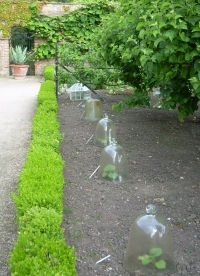
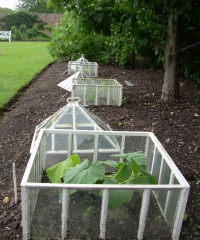 These pictures are of Victorian
garden cloches (bells) and cold frames. Acting as mini-glasshouses, they are an
elegant variation on the usual wooden
cold frames with window-pane rooves.
These pictures are of Victorian
garden cloches (bells) and cold frames. Acting as mini-glasshouses, they are an
elegant variation on the usual wooden
cold frames with window-pane rooves.
Cucumber frames often turn up in 19th century children's stories, where boys were constantly in trouble for breaking the glass. They warmed the earth and extended the growing season, so were crucial to the supply of "Mediterranean" summer vegetables in Britain, before the age of horticultural polythene and container-loads of tomatoes crossing the English Channel.
By warming the earth, frames with lights [windows] allowed seeds to be sown early, and extended the growing season. This meant a chance to experiment with seeds gathered from across the British Empire. As the Duke of Bedford's head gardener said in the 1830s: "Seeds from New Holland [Australia], the Cape [South Africa], and other mild climates, will vegetate readily by being placed in a cold frame ....".
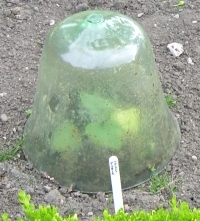
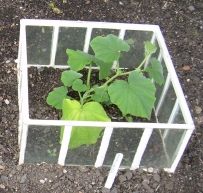 Longer, warmer summers in most of North America mean this 19th century equipment
was less well-known there, although cold frames were and are used by some keen US
gardeners.
Longer, warmer summers in most of North America mean this 19th century equipment
was less well-known there, although cold frames were and are used by some keen US
gardeners.
Some of the frost-sensitive squash growing in these pictures from northern England are butternut squash - far from exotic or tender in many places, but UK gardeners have to plan thoughtfully to take this newly fashionable food from seed to ripening before the end of the growing season.
Cottage gardening
Few people in northern latitudes could afford walled gardens with peaches trained on the walls, nor gardeners to oversee a large collection of glass, but by the later 19th century you didn't have to be posh to aspire to owning one or two cucumber frames. See left for a lover trying to "seduce" his lady with talk of pianos and garden frames.
The poorest cottagers had no money to buy glass for a cold frame, but could still grow a good variety of veg with spade, hoe and manure. Oxfordshire villagers living on farm labourers' wages in the 1880s also wanted to get their seedlings going as early in the year as possible.
They were first-class gardeners and it was their pride to have the earliest and best of the different kinds of vegetables. They were helped in this by good soil and plenty of manure from their pigsties; but good tilling also played its part. They considered keeping the soil constantly stirred about the roots of growing things the secret of success and used the Dutch hoe a good deal for this purpose. The process was called 'tickling'. "Tickle up old Mother Earth and make her bear!" they would shout to each other across the plots, or salute a busy neighbour in passing with: "Just tickling her up a bit, Jack?"
Flora Thompson, Lark Rise, 1939
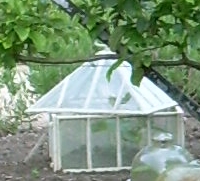 As well as the cottage garden they had an allotment or potato patch.
As well as the cottage garden they had an allotment or potato patch.
The garden was reserved for green vegetables, currant and gooseberry bushes, and a few old-fashioned flowers. Proud as they were of their celery, peas and beans, cauliflowers and marrows, and fine as were the specimens they could show of these, their potatoes were their special care for they had to grow enough to last the year round.
Flora Thompson, Lark Rise, 1939
See also: Medieval watering pot
 27 June 2007
27 June 2007
You may like our new sister site Home Things Past where you'll find articles about antiques, vintage kitchen stuff, crafts, and other things to do with home life in the past. There's space for comments and discussion too. Please do take a look and add your thoughts. (Comments don't appear instantly.)
For sources please refer to the books page, and/or the excerpts quoted on the pages of this website, and note that many links lead to museum sites. Feel free to ask if you're looking for a specific reference - feedback is always welcome anyway. Unfortunately, it's not possible to help you with queries about prices or valuation.


